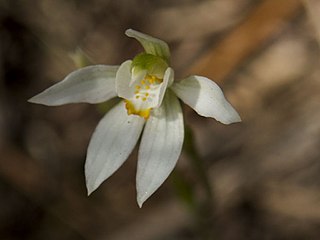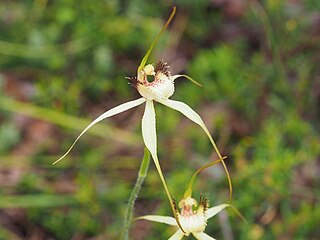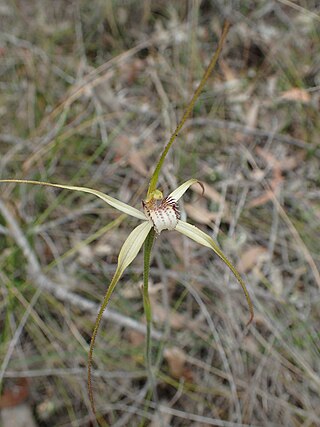
Caladenia fuscata, commonly known as dusky fingers, is a plant in the orchid family Orchidaceae and is endemic to eastern and south-eastern Australia, including Tasmania. It is a small ground orchid found in eucalyptus woodland and which flowers in September and October.

Caladenia arenaria, commonly known as the sand-hill spider orchid, is a plant in the orchid family Orchidaceae and is endemic to New South Wales. It is a ground orchid with a single, densely hairy leaf and one or two white or pale yellow flowers with maroon tips. Formerly much more widespread, it is now only known from about two thousand individual plants in five locations in the Riverina area and is classed as "Endangered".
Caladenia argocalla, commonly known as white beauty spider orchid, is a plant in the orchid family Orchidaceae and is endemic to South Australia. It is a ground orchid which grows singly or in loose groups and has a single, hairy leaf and one or two white to greenish-white flowers on a wiry, hairy stalk. The total population is thought to be between 2,000 and 4,500 and it is classed as an "Endangered" species.

Caladenia atrovespa, commonly known as the thin-clubbed mantis orchid, is a plant in the orchid family Orchidaceae and is endemic to New South Wales. It is a terrestrial, perennial, deciduous, herb with an underground tuber and a single hairy leaf. It is similar to Caladenia tentaculata but has smaller flowers, sepals with narrower glandular tips, straight lateral sepals and a narrower labellum. The species was first formally described by David Jones who gave it the name Arachnorchis atrovespa in The Orchadian from a specimen collected on Black Mountain in the Australian Capital Territory. In 2010, Gary Backhouse transferred the species to Caladenia as C. atrovespa. The specific epithet (atrovespa) is derived from the Latin words atra meaning "black" and vespa meaning "wasp", referring to the large black thynnid that pollinates this orchid.

Caladenia attingens, commonly known as mantis orchid, is a species of flowering plants in the orchid family Orchidaceae and are endemic to the south-west of Western Australia. There are three subspecies, each of which has a single hairy leaf and one or two brightly coloured flowers with upswept sepals and a labellum with long, comb-like fringes. The subspecies differ in size, distribution and habitat.
Caladenia audasii is a plant in the orchid family Orchidaceae and is endemic to Victoria. It is a rare ground orchid with a single hairy leaf and a single yellow flower.

Caladenia aurantiaca, commonly known as orangetip fingers, is a plant in the orchid family Orchidaceae and is endemic to Victoria, although it is also found on one Bass Strait island. It is a slender ground orchid with a single hairy leaf and one or two short-lived, orange-tipped, white flowers on a thin, wiry spike.

Caladenia busselliana, commonly known as Bussell's spider orchid, is a plant in the orchid family Orchidaceae and is endemic to a small area in the south-west of Western Australia. It is a rare orchid with an erect, hairy leaf and up to three pale yellow flowers. Only about fifty specimens are known and it is threatened by habitat destruction and by too-frequent or too infrequent bushfires.

Caladenia calcicola, commonly known as the Bats Ridges spider orchid, is a plant in the orchid family Orchidaceae and is endemic to a small area near the Victoria - South Australia border. It is a ground orchid with a single hairy leaf and one or two glossy, pale yellow flowers with maroon markings.

Caladenia catenata, commonly known as white caladenia, white fingers and lady's fingers, is a plant in the orchid family Orchidaceae and is endemic to New South Wales, Queensland and Victoria. It is a ground orchid with a single hairy leaf and one or two white, sometimes pink flowers on a thin, sparsely-hairy stem. It is similar to Caladenia carnea but lacks the red and white bars on the labellum of that species.

Caladenia christineae, commonly known as Christine's spider orchid, is a plant in the orchid family Orchidaceae and is endemic to the south-west of Western Australia. It has a single erect, hairy leaf and up to four small, white to cream-coloured flowers. It is distinguished from similar spider orchids by its small, odourless flowers with their stiffly held sepals and petals.
Caladenia concinna, commonly known as the neat spider orchid, is a plant in the orchid family Orchidaceae and is endemic to Australia. It is a ground orchid with a single hairy leaf, and usually a single greenish flower with red stripes on the petals and sepals.

Caladenia concolor, commonly known as the crimson spider orchid, is a plant in the orchid family Orchidaceae and is endemic to the south-east of Australia. It is a ground orchid with a single, sparsely hairy leaf, and one or two hairy, dark purplish-red flowers.

Caladenia conferta, commonly known as the crowded spider orchid or coast spider-orchid, is a plant in the orchid family Orchidaceae and is endemic to a restricted area in South Australia. It is a ground orchid with a single hairy leaf, and usually a single yellowish-green flower with red markings on a wiry, hairy stalk.
Caladenia cremna, commonly known as Don's spider orchid, is a plant in the orchid family Orchidaceae and is endemic to a small area in Victoria. It is a rare ground orchid with a single hairy leaf and a single yellow flower with red striations.

Caladenia cretacea, commonly known as Stuart Mill spider orchid, is a plant in the orchid family Orchidaceae and is endemic to a small area in Victoria. It is a rare ground orchid with a single leaf and one or two white flowers on a hairy stalk.
Caladenia hastata, commonly known as Mellblom's spider orchid is a plant in the orchid family Orchidaceae and is endemic to Victoria. It is a ground orchid with a single hairy leaf and up to three white to cream-coloured flowers with red markings on the labellum.
Caladenia quadrifaria, commonly known as the large pink fingers orchid is a plant in the orchid family Orchidaceae and is endemic to New South Wales. It is a ground orchid with a single, sparsely hairy leaf and up to three pale to bright pink flowers.

Caladenia pygmaea, commonly known as the pygmy finger orchid is a plant in the orchid family Orchidaceae and is endemic to South Australia. It is a ground orchid with a single erect, sparsely hairy leaf and a single pink flower with red stripes on the labellum. It was formerly known as a variety of Caladenia carnea.
Caladenia intuta is a plant in the orchid family Orchidaceae and is endemic to two small areas on the Yorke Peninsula in South Australia. It is a ground orchid with a single hairy leaf and one or two white flowers which sometimes have faint reddish lines.













